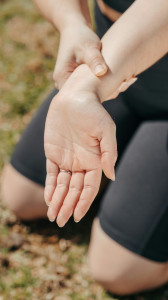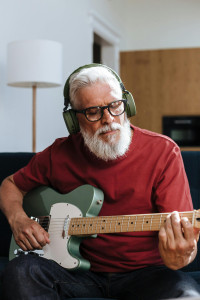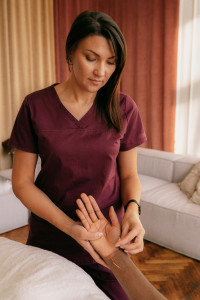 Playing the guitar can be a deeply rewarding experience, but it’s not without its challenges. Our hands are required to be precise and coordinated in their movements, or playing can become sloppy and ruin your performance. To keep your playing optimal, all your nerves need to be functioning properly, without compression. One area that can often cause compression of your median nerve is the Carpal Tunnel of the wrist. When the median nerve gets compressed in this narrow passageway, it’s called Carpal Tunnel Syndrome (CTS). CTS can affect anyone who performs repetitive motions with their hands and wrists, and guitarists are particularly susceptible due to the nature of their instrument, especially in their fretting hand (the left for most guitarists). In this article, we’ll explore the causes and anatomy of carpal tunnel syndrome, its signs and symptoms, treatment options, and most importantly, how guitarists can prevent it from hindering their passion for playing.
Playing the guitar can be a deeply rewarding experience, but it’s not without its challenges. Our hands are required to be precise and coordinated in their movements, or playing can become sloppy and ruin your performance. To keep your playing optimal, all your nerves need to be functioning properly, without compression. One area that can often cause compression of your median nerve is the Carpal Tunnel of the wrist. When the median nerve gets compressed in this narrow passageway, it’s called Carpal Tunnel Syndrome (CTS). CTS can affect anyone who performs repetitive motions with their hands and wrists, and guitarists are particularly susceptible due to the nature of their instrument, especially in their fretting hand (the left for most guitarists). In this article, we’ll explore the causes and anatomy of carpal tunnel syndrome, its signs and symptoms, treatment options, and most importantly, how guitarists can prevent it from hindering their passion for playing.
Causes and Anatomy of the Carpal Tunnel and Median Nerve
To understand carpal tunnel syndrome, it’s essential to first understand the anatomy of the wrist. The carpal tunnel is a narrow passageway on the palm side of your wrist. It’s formed by bones on the bottom and sides of the tunnel and a strong band of connective tissue called the transverse carpal ligament on the top.
Running through the carpal tunnel is the median nerve, which controls sensations to the palm side of the thumb and fingers (except the little finger). It also controls the muscles around the base of the thumb. When the median nerve becomes compressed or squeezed, it can lead to the symptoms of carpal tunnel syndrome. It’s important to note that there are other conditions that can mimic carpal tunnel syndrome, including pronator teres syndrome, where the median nerve is compressed further up the forearm, or even cervical radiculopathy, where the nerve roots are compressed as they leave the neck.
Signs and Symptoms of Carpal Tunnel Syndrome
The symptoms of carpal tunnel syndrome can vary from mild to severe and often develop gradually. Common symptoms include:
– Numbness or tingling in the thumb, index, middle, or ring fingers
– Weakness in the hand, making it difficult to grip objects (or the neck of your guitar)
– Pain or aching in the hand or wrist
– A sensation like an electric shock that shoots from the wrist into the hand
If left untreated, carpal tunnel syndrome can lead to permanent nerve damage, so it’s essential to seek treatment if you suspect you have it.
Treatment of Carpal Tunnel Syndrome
Once carpal tunnel syndrome as been diagnosed, we are able to put together a treatment program to help relieve the compression of the nerve, and allow it to function properly. Treatment for carpal tunnel syndrome depends on the severity of the symptoms. Most cases can be managed with conservative treatments such as:
Activity modification
For guitarists, the act of playing the guitar can often be the factor that caused the symptoms in the first place. Prolonged flexion of the wrist compresses the carpal tunnel, putting pressure on the median nerve. If this is a factor, it can be helpful to temporarily take a break from practicing to allow the nerve to heal. It’s also helpful to analyze how your wrist is positioned while you’re playing. Are you holding the guitar low, forcing your wrist to bend more than it needs to? Sometimes tightening your strap and raising where you guitar sits on the body can reduce the need for your wrist to be as flexed, and can alleviate symptoms. 
Splinting or bracing
Using a splint or wrist brace can help prevent the wrist from flexing too much while the injury is healing. It’s not recommended to wear a wrist brace all the time, but it can be helpful at times when you know you’re prone to over flexing your wrist, such as while sleeping.
Soft tissue therapies
A trained manual therapist such as a chiropractor, physiotherapist, or massage therapist can help release tension in the surrounding muscle groups of the forearm and wrist to take pressure off the nerve and allow it to heal quicker.
Anti-inflammatory medication
Some doctors may recommend a short course of anti-inflammatory medication to help reduce swelling and fluid buildup in the wrist. Always consult your pharmacist or physician before starting any course of medication to make sure it’s the right option for you.
Ice
The application of ice can help decrease inflammation and take pressure off the nerve. It is important that you ice the tissue for no longer than 10 minutes at a time, and then remove it for at least 10 minutes. This is because if ice is left on for too long the blood vessels will open up in the area to prevent frost bite, which effectively increases the inflammation in the area, which is counterproductive. Try icing for 10 on and 10 off for up to an hour.
Electroacupuncture
Acupuncture can be used to help relax surrounding muscle groups, and stimulate the nerve. We can also apply a small electrical current beyond the site of entrapment to help stimulate the muscles that aren’t getting as much stimulation as a result of the nerve compression. This stimulates healing, and helps prevent atrophy of key muscles of the hand. There have been studies such as this one that show that electroacupuncture can be a valuable addition to a treatment plan for carpal tunnel syndrome. ”
”
Stretching and strengthening
Your practitioner will likely suggest exercises that can help stretch tightened muscles of the forearm, and strengthen muscles that lack the strength to properly stabilize the wrist and hand. These exercises will be prescribed on an individual basis, as every case is different.
Nerve flossing
Nerve flossing is a technique used to help entrapped nerves to glide back and forth between the site of compression. It involves tensioning the nerve from one side, while relaxing the nerve from the other side, allowing it to be pulled through. The positioning is then reversed so the nerve is pulled back through the entrapment site the other way. This is performed repetitively, and helps maintain mobility of the nerve as it heals.
Surgery
If conservative efforts fail, surgical intervention may be necessary. While techniques may vary, the surgeon will often cut through the transverse carpal ligament to give the median nerve extra room, alleviating compression.
Preventing Carpal Tunnel Syndrome as a Guitarist
Prevention is key when it comes to carpal tunnel syndrome, especially for guitarists who rely heavily on their hands and wrists. Here are some tips to help prevent CTS:
Maintain Proper Technique: Ensure that you’re holding your guitar correctly and using proper hand and wrist positioning while playing. Avoid bending your wrist excessively or holding it in an awkward position for extended periods. As I mentioned above, raising your guitar strap can help reduce the need for the wrist to be over flexed.
Take Frequent Breaks: Give your hands and wrists a break during practice or performance. Stretching and flexing your hands and wrists can help prevent stiffness and strain.
Warm up properly: It’s important to make sure that the muscles in your forearm and hand are properly warmed up prior to starting any more difficult parts. This can include any of the thousands of simple fingerboard exercises we all grew up practicing. Scales are a great way to start. You can also simply play with alternating picking while using each of your fingers in order, chromatically. 
Stay Active and Healthy: Regular exercise can help maintain strength and flexibility in your hands and wrists. Additionally, maintaining a healthy weight can reduce your risk of developing CTS.
Listen to Your Body: Pay attention to any signs of discomfort or strain in your hands and wrists. If you experience symptoms of CTS, take a break and consult a healthcare professional.
By understanding the causes and symptoms of carpal tunnel syndrome and taking proactive steps to prevent it, guitarists can continue to enjoy playing their instrument for years to come. If you’re experiencing symptoms of CTS, it’s essential to seek medical advice to prevent further damage and explore treatment options tailored to your needs.
 Dr. Tim Lahn is a Chiropractor and avid musician in Barrie, Ontario. He is passionate about treating musicians with injuries, and educating them about their bodies and the unique challenges presented by their instruments of choice. His ultimate goal is to get his patients back to the studio and the stage, doing what they love to do. To book an appointment call Complete Care Chiropractic in Barrie at (705) 722-3131.
Dr. Tim Lahn is a Chiropractor and avid musician in Barrie, Ontario. He is passionate about treating musicians with injuries, and educating them about their bodies and the unique challenges presented by their instruments of choice. His ultimate goal is to get his patients back to the studio and the stage, doing what they love to do. To book an appointment call Complete Care Chiropractic in Barrie at (705) 722-3131.
